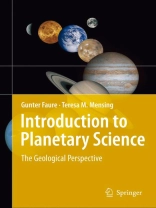This textbook details basic principles of planetary science that help to unify the study of the solar system. It is organized in a hierarchical manner so that every chapter builds upon preceding ones.
Starting with historical perspectives on space exploration and the development of the scientific method, the book leads the reader through the solar system. Coverage explains that the origin and subsequent evolution of planets and their satellites can be explained by applications of certain basic principles of physics, chemistry, and celestial mechanics and that surface features of the solid bodies can be interpreted by principles of geology.
สารบัญ
Preface
1. The urge to explore
2. From speculation to understanding
3. The planets of the solar system
4. Life and death of stars
5. Origin of the solar system
6. The earth: model of planetary evolution
7. The clockwork of the solar system
8. Meteorites and impact craters
9. The Earth-Moon system
10. Mercury: too hot for comfort
11. Venus: planetary evolution gone bad
12. Mars: the little planet that could
13. Asteroids: shattered worlds
14. Jupiter: heavy-weight champion
15. Galilean satellites: jewels of the solar system
16. Saturn: the beauty of rings
17. Titan: an ancient world in deep freeze
18. Uranus: what happened here?
19. Neptune: more surprises
20. Pluto and Charon: the odd couple
21. Ice worlds at the outer limit
22. Comets: coming inside from the cold
23. Earth: the cradle of humans
24. Brown-dwarf stars and extrasolar planets
Appendix I. Mathematical equations used in astronomy
Appendix II. Summaries of physical and orbital parameters
Glossary
Author Index
Subject Index












